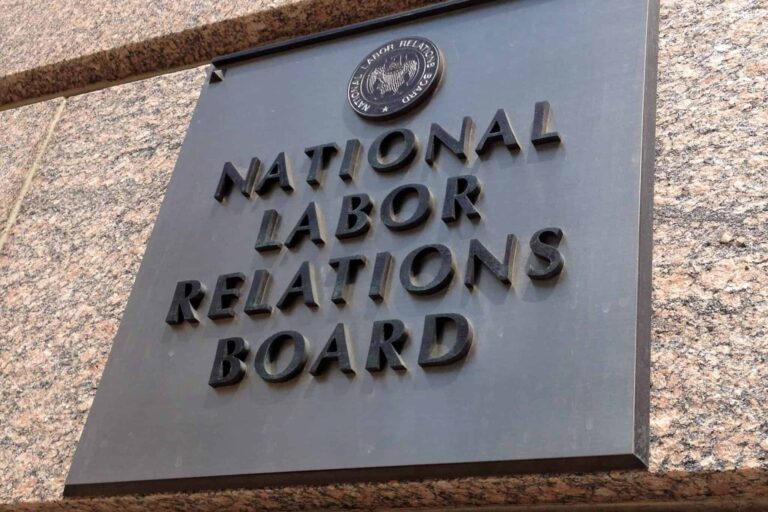
Andrew Strom has been a union lawyer for more than 25 years. He is an Associate General Counsel of Service Employees International Union, Local 32BJ in New York, NY. He is the author of Caught in a Vicious Cycle: A Weak Labor Movement Emboldens the Ruling Class, 16 U.St. Thomas L.J. 19 (2019); Boeing and the NLRB: A Sixty-Four Year-old Time Bomb Explodes, 68 National Lawyers Guild Review 109 (2011); and Rethinking the NLRB’s Approach to Union Recognition Agreements, 15 Berkeley J. Emp. &; Lab. L. 50 (1994), and has written for Dissent and Dollars and Sense. He also taught advanced legal writing at Fordham Law School. He received his J.D. magna cum laude from Harvard Law School. The views he expresses on this blog are his personal views, and should not be attributed to SEIU Local 32BJ.
The House Education and Labor Committee recently revealed that the Trump appointees on the NLRB are hiring a private contractor to help review the public comments submitted in response to their proposed joint employer rule. NLRB Chairman John Ring told the Members of Congress not to worry because the contractor would only do an “initial sorting and coding of the public comments,” and the Board’s professional staff would still perform the substantive review of the nearly 29,000 comments. But Ring’s attempt at reassurance fails to explain why the NLRB continues to push ahead with its joint employer rulemaking despite (1) an opinion by the D.C. Circuit indicating that the proposal, as drafted, will not survive court review; (2) the lack of any evidentiary support for the proposed rule in the public comments; and (3) Ring’s acknowledgment that the agency faces “budget challenges” and work on the rule makes it harder for the Board’s attorneys to “remain focused on pending cases.”
Shortly after the Board published the proposed rule, the D.C. Circuit issued a decision that should have sent the Board back to the drawing board. The proposed rule provides that an entity’s right to control the terms and conditions of its contractor’s employees will not make the entity into a joint employer unless there is evidence that the entity has repeatedly exercised that right of control. By contrast, under the Board’s Browning-Ferris decision, the right to control could be sufficient without the need for proof that the right had been exercised. Last December, the D.C. Circuit agreed that under the common law, the right to control is more important than whether the control has been exercised.
The D.C. Circuit’s decision in Browning-Ferris also establishes that a second key aspect of the Trump Board’s proposed rule is flawed. The proposed rule provides that in order to qualify as a joint employer, an entity must exercise “direct and immediate control over the employees’ essential terms and conditions of employment…” But, the D.C. Circuit held that a “rigid distinction between direct and indirect control has no anchor in the common law.” So, unless the proposed rule is substantially rewritten, it will be dead on arrival at the D.C. Circuit. But, even a major rewrite can’t save the rule because under the Administrative Procedure Act, a final rule must be the “logical outgrowth” of a proposed rule. If the Trump Board Members weren’t so single-mindedly focused on reversing every major decision by the Obama Board, they would have simply withdrawn the proposed rule after the D.C. Circuit’s decision.
The D.C. Circuit’s decision is not the only hurdle the Board must overcome in its effort to salvage any part of the proposed rule. The employer community also didn’t do the Board any favors. After years of the hearing the same Republican talking points about how devastating the Browning-Ferris decision was, I’m sure the Board Members were hoping that the Chamber of Commerce, the International Franchise Association (IFA), and other organized employer groups would provide some empirical data, or at least some real-life examples, regarding the need for a rule that makes it much easier for lead firms to avoid a joint employer finding. If so, they were sorely disappointed. The AFL-CIO submitted a devastating critique of the comments submitted in support of the proposed rule. The AFL-CIO pointed out that employer groups collectively claimed to speak for millions of employers across the country, yet they could not identify a single instance where an employer did not enter into a business relationship, or terminated a contract, or experienced any adverse impact whatsoever due to the Browning-Ferris decision. Instead of providing any actual examples or data, the Chamber of Commerce and the IFA pinned all their hopes on a survey conducted by a staff economist at the Chamber of Commerce. The survey could not have survived the most generous peer review. While the IFA asserted that there are 233,000 small business franchisee companies across the country, the survey consisted of interviews of only 36 franchisee business owners, as well as 28 franchisor executives, and 13 other “knowledgeable observers” – there was no claim that the participants in the survey were randomly selected. The IFA did not provide the full list of questions asked during the survey, but the questions that were disclosed indicate that the surveyors employed leading questions — for instance, describing certain services as “valuable” in a question asking respondents how much they would be willing to pay to obtain the services.
Based entirely on this flawed survey, and without any empirical data to back it up, the IFA and the Chamber of Commerce made the absurd claim that the Browning-Ferris decision had resulted in between $17.2 and $33.3 billion in lost output per year. What’s especially ridiculous about this claim is that the IFA’s website features a report on the franchise sector based on real data that demonstrates steady growth in the franchise sector before and after the Browning-Ferris decision. In fact, the report states that 2016, the first full year after Browning-Ferris was decided, was “a very strong year of employment and output growth” in the franchise restaurant industry. Needless to say, if the Browning-Ferris decision had actually led to billions of dollars in lost output, there would be some empirical data showing that loss.
The Chamber of Commerce and other employer groups would have you believe that under the current joint employer standard, large firms will never contract out work or provide technical assistance to franchisees out of fear of being deemed a joint employer by the NLRB. Leaving aside the fact that under longstanding Board law, a joint employer is not automatically liable for illegal acts committed by its co-employer, or that illegal acts under the NLRA rarely lead to substantial liability, if this fear is genuine, there is a very easy way to address it. The firms that are worried that they might somehow incur liability due to the actions of their contractors or franchisees can simply require the contractor or franchisee to indemnify them. This is the kind of market-based solution that, in theory, ought to be appealing to a Republican Administration.
Given that there is neither a legal case nor an evidentiary basis for the Board’s proposed rule, it will likely go down as yet another Trump Administration loss in the courts. The good news is that as much as I hate to see the NLRB waste tax dollars on a doomed enterprise, workers across the country should breathe a sigh of relief that the Board is wasting its time on a rulemaking venture that will not survive court review rather than on issuing more anti-worker decisions.









Daily News & Commentary
Start your day with our roundup of the latest labor developments. See all
April 19
Alabama and Louisiana advance anti-worker legislation; Mercedes workers in Alabama set election date; VW Chattanooga election concludes today.
April 18
Disneyland performers file petition for unionization and union elections begin at Volkswagen plant in Tennessee.
April 18
In today’s Tech@Work, a regulation-of-algorithms-in-hiring blitz: Mass. AG issues advisory clarifying how state laws apply to AI decisionmaking tools; and British union TUC launches campaign for new law to regulate the use of AI at work.
April 17
Southern governors oppose UAW organizing in their states; Florida bans local heat protections for workers; Google employees occupy company offices to protest contracts with the Israeli government
April 16
EEOC publishes final regulation implementing the Pregnant Workers Fairness Act, Volkswagen workers in Tennessee gear up for a union election, and the First Circuit revives the Whole Foods case over BLM masks.
April 15
The Supreme Court ruled in favor of bakery delivery drivers in an exemption from mandatory arbitration case; A Teamsters Local ends its 18-month strike by accepting settlement payments and agreeing to dissolve